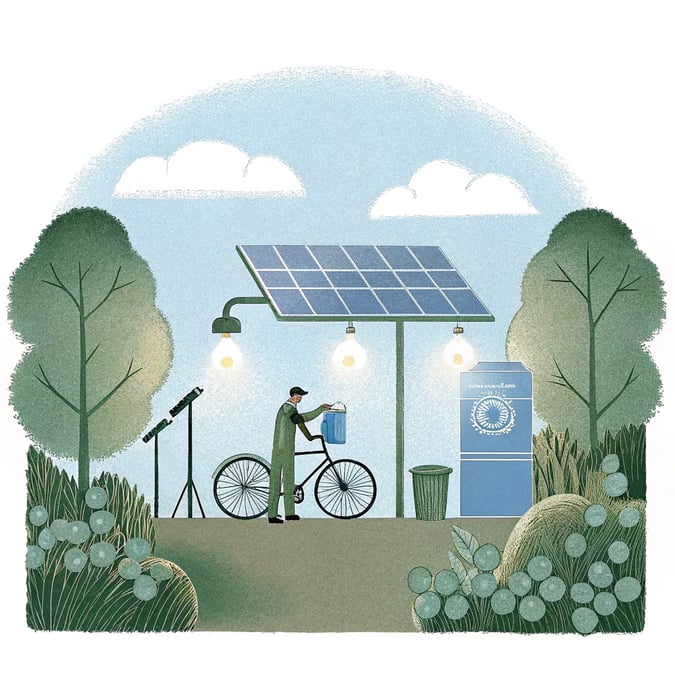
Bicycles represent one of the most environmentally friendly modes of transportation available today. They produce zero emissions, require no fossil fuels, and take up minimal space. But even this green machine needs regular maintenance to keep it running smoothly. The good news? You can maintain your bike using eco-friendly methods that align with its sustainable nature.
Why Eco-Friendly Bike Maintenance Matters
When I first started cycling regularly, I never thought about the environmental impact of how I maintained my bike. I'd spray on harsh degreasers, rinse them into the storm drain, and toss old parts without a second thought. Then last summer, I noticed dead vegetation where I'd been washing my bike—a wake-up call that changed my approach completely.
The chemicals in conventional bike cleaners and lubricants can contain toxic compounds that harm aquatic ecosystems when they wash into waterways. Many bike parts are also recyclable or reusable, yet often end up in landfills. By adopting greener maintenance practices, you're extending your bike's environmental benefits beyond just transportation.
"The average cyclist might use several aerosol cans of degreaser and lubricant annually, potentially releasing harmful VOCs into the atmosphere," notes the European Cycling Federation, which advocates for sustainable cycling practices across all aspects of bike ownership.

Eco-Friendly Cleaning Solutions
DIY Bike Cleaners
Commercial bike cleaners often contain chemicals that can harm the environment. Creating your own cleaners is surprisingly easy:
Basic Bike Wash
- 1 tablespoon mild dish soap (look for plant-based options)
- 1 gallon warm water
- Optional: 2 tablespoons baking soda for extra degreasing power
This simple solution works for general cleaning and is biodegradable. I've used this mixture for years on everything from my road bike's frame to my mountain bike's muddy tires.
Natural Degreaser
- ½ cup white vinegar
- ¼ cup baking soda
- 2 cups warm water

This mixture effectively cuts through chain grime and grease without harsh chemicals. It's not quite as powerful as commercial degreasers, so you might need to let it sit a bit longer, but it gets the job done without environmental harm.
Sustainable Cleaning Practices
Where you clean your bike matters as much as what you use. Always wash your bike on grass or gravel rather than pavement, allowing natural filtration before runoff reaches waterways. Collect heavily soiled water in a bucket and dispose of it properly.
According to the California Air Resources Board, "Even small amounts of chemicals can accumulate in local waterways and affect aquatic life. Proper disposal of cleaning materials is an essential part of environmental stewardship."
Green Lubrication Options
Plant-Based Lubricants
Traditional bike lubricants often contain petroleum products and toxic additives. Fortunately, the market for plant-based alternatives has grown considerably:
- Plant-based chain oils made from vegetable oils perform admirably in most conditions
- Beeswax-based products provide excellent water resistance for wet-weather riding
- Biodegradable greases for bearings and moving parts
I switched to a soy-based chain lube last year and honestly can't tell the difference in performance—except that it has a much more pleasant smell!
Application Tips for Minimal Waste
- Apply lubricants precisely using needle applicators to avoid excess
- Wipe off excess oil immediately to prevent dripping and waste
- Store lubricants properly to prevent evaporation and spills
"Proper lubrication not only reduces friction and wear on your components but also improves efficiency, meaning you'll expend less energy while riding," explains bike mechanic Sarah Chen from Green Gears Bike Shop in Portland.
Sustainable Parts Replacement and Disposal
Extending Component Life
The most eco-friendly part is the one you don't have to replace. Regular maintenance extends the life of your components:
- Rotate tires to ensure even wear
- Clean and lubricate chains weekly if you ride frequently
- Adjust derailleurs and brakes before they cause damage to other components
My cassette lasted nearly twice as long once I got serious about chain maintenance. What used to be an annual replacement now happens every two years or more.
Responsible Disposal and Recycling
When parts do wear out:
- Metal components (chains, cassettes, derailleurs) can be recycled with scrap metal
- Rubber (tires, tubes) can often be recycled through specialty programs
- Consider upcycling—old chains make great keychains, and worn tires can become belts or bags
Many local bike shops participate in recycling programs. Specialized Bicycles runs a tire recycling program at many of their dealers, turning old rubber into playground materials.

How Can I Make My Bike Maintenance Routine More Water-Efficient?
Water conservation is an important aspect of eco-friendly bike maintenance. Here are some practical approaches:
- Use a spray bottle instead of a hose for applying cleaning solution, which dramatically reduces water usage
- Employ microfiber cloths that clean effectively with minimal water
- Collect rainwater in a barrel specifically for bike cleaning purposes
- Time your cleaning sessions strategically—a slightly damp bike after a light rain needs less water to clean
I've found that keeping a dedicated bucket for bike washing helps me track and minimize my water usage. Last summer, during water restrictions in my area, I managed to clean my bike thoroughly using less than a gallon of collected rainwater.
Tools and Accessories for Sustainable Maintenance
Durable, Eco-Friendly Tools
Investing in quality tools reduces waste and consumption:
- Look for tools with lifetime warranties
- Choose wooden or metal handles over plastic when possible
- Consider multi-tools that serve multiple purposes
My Park Tool wrench set is 15 years old and still works perfectly—the initial investment has paid off environmentally and financially.
Storage Solutions
Proper storage of maintenance supplies prevents waste and contamination:
- Use reusable containers for homemade cleaners
- Store chemicals in cool, dry places to prevent degradation
- Label everything clearly to avoid mistakes and waste
Building a Maintenance Schedule
Regular maintenance prevents major issues that might require resource-intensive repairs or premature part replacement:
Weekly:
- Wipe down frame and components
- Check tire pressure
- Inspect chain condition
Monthly:
- Deep clean drivetrain
- Check brake pad wear
- Inspect cables for fraying
Seasonally:
- Complete drivetrain disassembly and cleaning
- Check bearing systems
- Inspect frame for damage
"A well-maintained bicycle can last decades with minimal resource consumption," says bicycle historian and conservationist James Parker from the Sustainable Transportation Alliance. "Some of the most environmentally friendly bikes are vintage models that have been properly maintained for generations."
Community Resources
Many communities offer shared resources for bike maintenance:
- Tool libraries where you can borrow specialized equipment
- Community bike shops that offer workspace and guidance
- Skill-sharing workshops to learn maintenance techniques
These resources reduce the need for individual tool ownership and build community around sustainable transportation.
Conclusion
Maintaining your bike in an eco-friendly way extends its environmental benefits beyond just being a zero-emission vehicle. By using natural cleaning products, plant-based lubricants, and practicing responsible parts replacement, you're contributing to a more sustainable cycling ecosystem.
I've found that these green maintenance practices not only benefit the environment but often save money and result in a better-performing bike. My components last longer, my bike runs smoother, and I feel better knowing my maintenance routine aligns with my values.
Disclaimer: This content is provided for informational purposes only. Always follow manufacturer recommendations for your specific bicycle and components. Some bikes may have special maintenance requirements that should take precedence over general advice.
Tags

About Elliott Greenway the Author
Elliott Greenway is a seasoned environmentalist and avid cyclist with over a decade of experience promoting sustainable transport solutions. His expertise in eco-friendly cycling has inspired countless individuals to take up cycling as a means to reduce their carbon footprint and embrace a healthier lifestyle.
Recommended Articles
US Innovations That Are Shaping the Future of Everyday Life
Explore how U.S. innovations in smart homes and AI are revolutionizing everyday life, enhancing convenience, and promoting sustainability.
How to Make an Older Car Smell Fresh Again According to Mechanics
Learn simple tips from mechanics to make your older car smell fresh again, from upholstery cleaning to natural deodorizing methods.
2025 Toyota Crown Delivers Hybrid Luxury With Unexpected Power
Discover the 2025 Toyota Crown, a luxurious hybrid sedan offering impressive performance, comfort, and cutting-edge technology for a unique driving experience.
2026 Volkswagen Tiguan Arrives With More Space and Style
Discover the 2026 Volkswagen Tiguan, featuring expanded space, modern tech, and stylish updates perfect for families on the go.
Top Cloud Storage Services for Safer, Smarter Backup
Discover top cloud storage services in 2025 for safer backups, featuring options like OneDrive, Google Drive, and more for secure and easy access.




